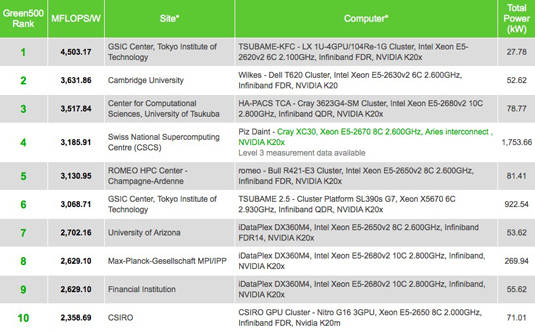This article is more than 1 year old
Green supercomputer benchmarks make boffins see red, check blueprints
Top 10 use GPU brawn, but has anyone any bright ideas on better juicy tests?
SC13 The biannual Green500 list of the most energy-efficient supercomputers has broken new ground in two important ways: for the first time an HPC system broke the 4 gigaflops per watt barrier, and also for the first time all the top 10 systems benefitted from GPU acceleration. Then there's a third bit of note: the benchmarks are rubbish.
The list, measured in floating-point operations per watt when running the Linpack benchmark, was announced Wednesday at the SC13 supercomputing conference in Denver, Colorado. The top finisher, the 2,720-core TSUBAME-KFC from the GSIC Center, Tokyo Institute of Technology may have topped the Green500 energy-miser list, but it ranked at number 311 on the "performance is all we care about" Top500 list announced Monday.
TSUMABE-KFC is a purpose-built prototype created specifically at GSIC to study advanced cooling and low-power supercomputing, and its designers did their jobs well, with the system scoring a cool 4,503.17 megaflops per watt (Mflops/W).
To put that achievement in perspective, the number-one ranking in the previous Green500 list, published in June 2013, was held by the Eurora system from Italy's Cineca, which produced 3,208.83 Mflops/W to win the crown. Not too shabby, not too shabby at all – but TSUMABE-KFC bested Eurora by a full 40 per cent.
For fans of truly big iron, perhaps most the most interesting system on the list is Piz Daint from the Swiss National Supercomputing Centre (CSCS), which ranked number four with a megafloppage per watt of 3,185.91 (more on that score later). Piz Daint is the highest-ranking petaflop-capable super on the Green500 list, and also scored an impressive sixth place on the Top500 list.
By way of comparison, the two systems ahead of Piz Daint in the Green500 were ranked in triple digits in the Top500: Cambridge University's Wilkes was number two in the Green 500 but 166 in the Top500, and the University of Tsukuba, Japan's Center for Computational Sciences HA-PACS TCA was number three in the Green500 and number 134 in the Top500.
Piz Daint's performance in the Top500 was notable in one other way. In the June 2013 list it ranked 42; in the November list it rocketed up to number six. The reason? The addition of Nvidia Tesla K20X GPU accelerators to its 28-rack Cray XSC30 system.
Which leads us to the second notable thing about the new Green500 list: of the top 10 performers, all ten were boosted by Nvidia Tesla GPU accelerators: seven were equipped with Tesla K20X cards, two with K20s, and one with a K20M – which is essentially a K20.
In June, by comparison, only three of the top 10 systems had GPU accelerators: two with Nvidia Tesla K20s, and one with AMD FirePro S10000s. Another had Intel Xeon Phi coprocessor cards; no Xeon Phi–equipped system made the top 10 of the most recent Green500 list.

